The 1866 Womens Suffrage Petition
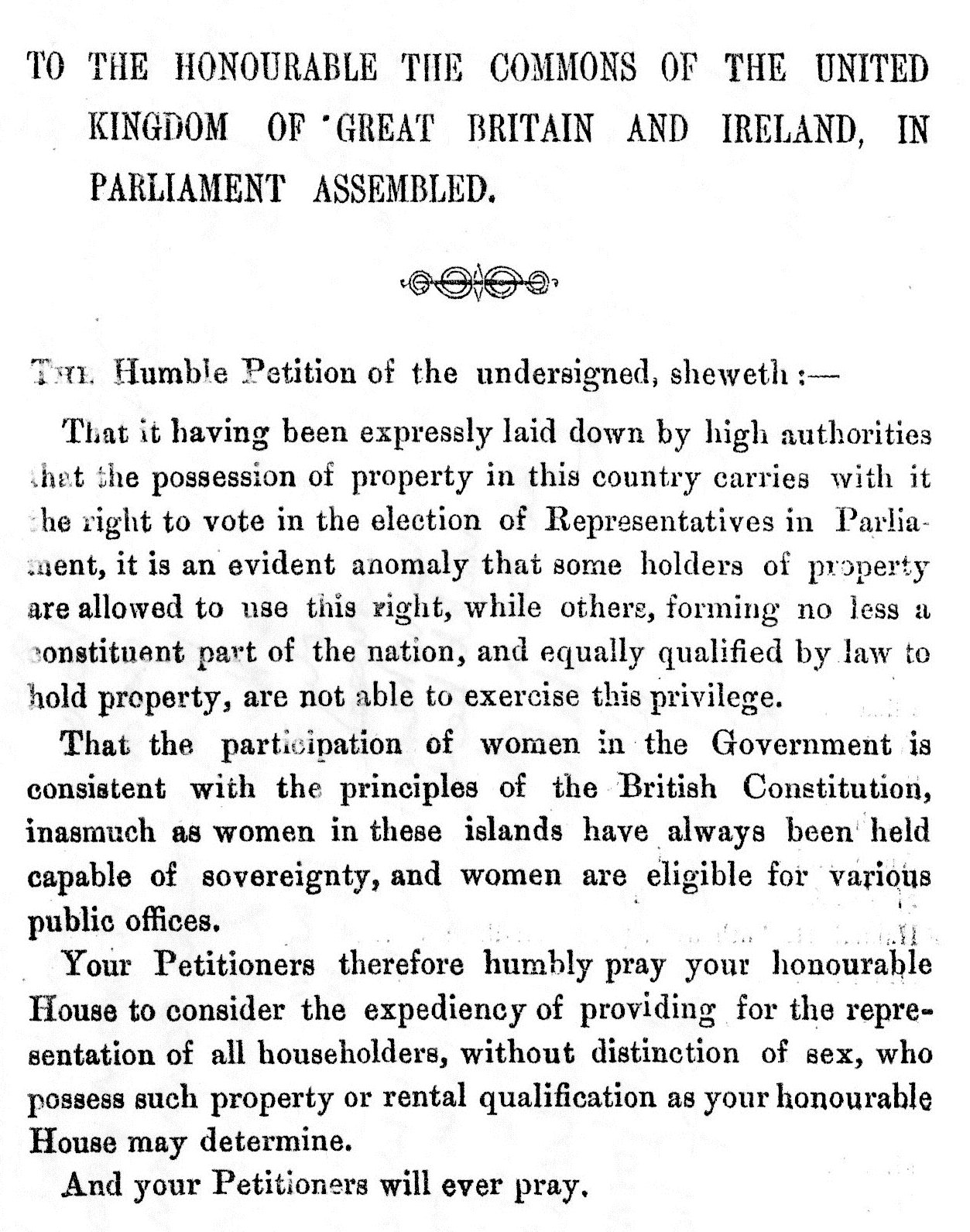
Historians often date the Women's Rights Movement from the Women's Suffrage Petition presented to Parliament on 7 June 1866.
The Petition was organised by the members of The Kensington Society, a debating society for women. Over the previous 15 years this group had
- campaigned for reforms to married women's property rights;
- campaigned for equal divorce rights;
- founded their own periodical and established an all-female printing press to publish it;
- provided a public platform for feminist writings and discussion of women's rights – or lack thereof;
- Encouraged women's further education by:
- persuading Cambridge and Oxford Universities to hold external examinations for women;
- lobbying to open university education and medical training to women;
- formed an employment agency and pressure group, "The Society for Promoting the Employment of Women"
In 1865, John Stuart Mill included women's suffrage in his election campaign to be MP for Westminster. Several Kensington Society members supported him and, in return, he offered to present a suffrage Petition on their behalf if they could achieve at least 100 signatures.
Although the Kensington Society was London based, it had created a nationwide network of contributors and sympathisers. The Society's secretary sent the Petition to every "corresponding" member. When the copies were returned, she collated the signatures alphabetically and printed copies of the Petition with its accompanying signatures which were sent to every MP and every member of the House of Lords. This is why the names and addresses of the signatories are known; Petitions were routinely destroyed after formal presentation. Only two copies of the Petition survive; one at Girton College in Cambridge and the other in private hands.
1466 women signed; 106 are from Leeds, the greatest number from any town outside London except Manchester.
"To believe in the transubstantiation or the divinity of the Virgin is not so perverting to the mind as to believe that women have no rights to full development of all the faculties and exercise of all their powers."
Barbara Leigh Smith 1858
"With regard to the property of women, there is taxation without representation, for they pay taxes without having the liberty of voting for representatives, and indeed there seems at present no reason why single women should be denied this privilege."
Note to Blackstone's Commentaries on the Laws of England, Edited by Edward Christian 1793-1795
An Incident in Connection with the Presentation of the First Women's Suffrage Petition to Parliament in 1866
By Bertha Newcombe, 1910, member of the Artists' Suffrage League
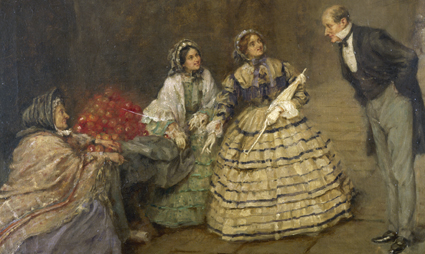
The story goes that the organisers of the Petition agreed to meet John Stuart Mill outside the Houses of Parliament to give him the document. Embarrassed by its weight and size, they hid it under the cart of a nearby apple seller, who then asked if she might add her name.
This rather sentimentalized depiction shows Emily Davies and Elizabeth Garrett Anderson directing John Stuart Mill to look under the cart.In fact Emily Davies had sent a printed copy of the Petition with all the signatures attached to every member of the House of Commons and the House of Lords. She also sent copies to all the weekly newspapers.
Her own copy survives in the archives of Girton College, Cambridge, which she founded.
The suffrage historian, Elizabeth Crawford, discovered another copy on a stall in the Portobello Road. She tells her story on her website here
The Parliamentary Archives have now digitised the Petition. It can be searched by name or by location.
It may be downloaded as a .pdf here
Collecting The Signatures In Leeds
The pattern of collecting signatures to the Petition was the same in Leeds and Manchester. The canvasser in both towns concentrated on locating working-class women who were head of household and so would have qualified for the vote if granted on the same terms as men.
This is very different from the signatures in other towns, who are mostly middle-class women, friends and correspondents of the London-based organisers of the Petition, The Kensington Society.
Historians have speculated that the Leeds signatures were collected by Ellen Heaton, a member of the Kensington Society. She certainly signed but there is little other evidence of her involvement in women's suffrage.
We know the signatures in Manchester were collected by Elizabeth Wolstoneholme, a school teacher and Secretary of the Manchester branch of the Schoolmistresses Association. The Secretary of the Leeds branch was Constance Holland.
Did Constance collect the signatures in Leeds? She signed it as did her sister, Helen, and her next-door neighbour, (Elizabeth Armitage). It was also signed by her other sisters, Fanny and Jessy Holland (living in Wortley) and 8 of their neighbours. Fanny Holland living at 59 Oakley Square, Camden, London was an aunt. Constance also collected signatures for the first women's suffrage Petition specifically from Leeds in 1868. As a committee member of the Leeds Women's Suffrage Society she was responsible for encouraging working women to become politically engaged and to use their votes in local elections.
The bulk of the 106 Leeds signatures come from a relatively small area of Woodhouse, as illustrated by the map: 13 women who signed lived in Raglan Road or Raglan Place and 27 lived on Woodhouse Street.
Nearly three-quarters of the women who signed the Petition in Leeds moved address at least twice between the 1861 census and the 1871 census. Such frequent moves caused by changes in fortune reflect the vulnerability at that time of single women and widows (especially those with young families) which might have been alleviated by improved legal status.
Who Signed the Petition
The map below shows that a substantial number of the women from Leeds who signed the Petition were from the Woodhouse area
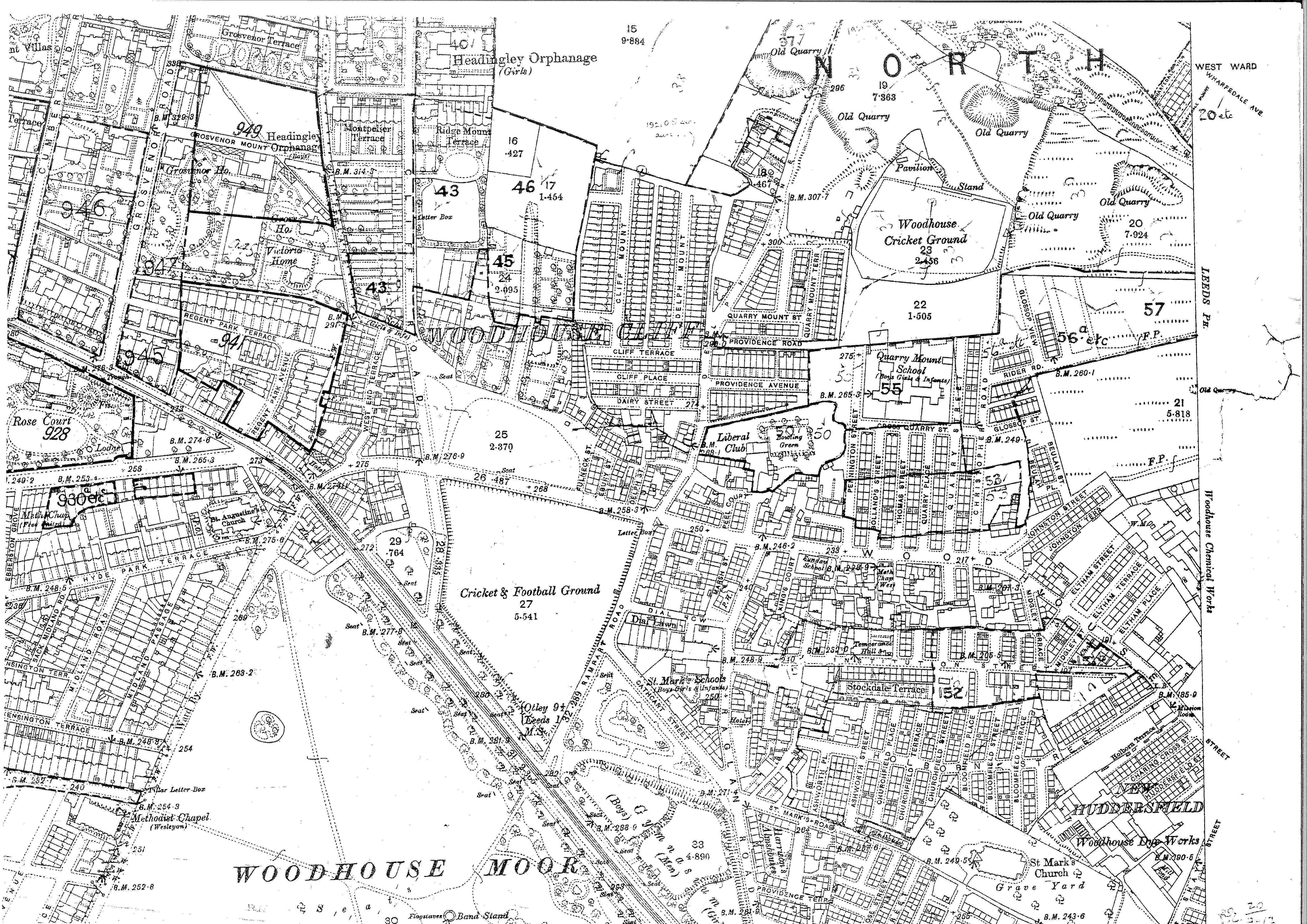
JANE AIREDALL or ARDILL
Born 1820
Died between 1881 and 1891
Address in 1866 on the Petition: 9 Moor Street
Marital status: Widow
Occupation: Unknown
Her husband had been a farmer, a cordwainer and a manufacturer of hooks and fastenings. She had at least 2 daughters. One (also called Jane) was a teacher who married a John Lee.
In the 1881 census, Jane senior was living with her daughter Mary and son-in-law, John Dufton, in York; she does not appear in the 1891 census.
Charlotte Alderson
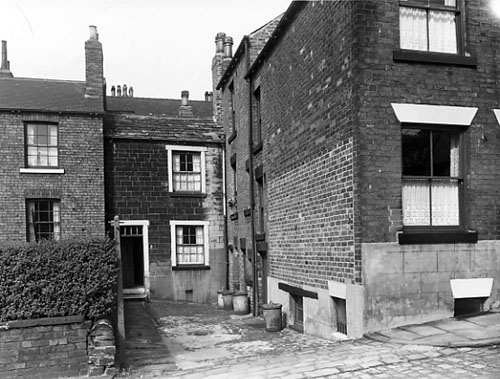
Address in 1866 on the Petition: 18 West End Terrace, Hyde Park
Charlotte was the wife of George Alderson, who is described in the 1861 census as “a cow catcher”. By the 1871 census, he has reached the status of “farmer with 17 acres”, employing a boy. At his death in 1879, he was described as a “dairyman”.
West End Terrace still exists but only as a name on a map. The alley behind the Hyde Park Pub that runs up the back of Regent Park Avenue has no street signs and only a small cobbled area where cars are parked indicates where the terrace was once.
Anne Briggs and Hannah Bolton
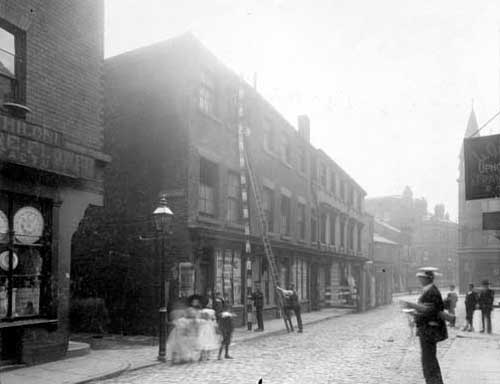
Ann Briggs born 1815 died after 1891
Address in 1866 on the Petition: 51 Wade Lane
Marital status: single
Occupation: Baby Linen Maker
Hannah Bolton - dates unknown
Address in 1866 on the Petition: 55 Wade Lane
Marital status: unknown
Occupation: Baby Linen Maker
Ann Briggs ran a Baby Linen Repository from 51 Wade Lane. At a time when most clothes were hand stitched, she would have employed neighbours such as Hannah Bolton as seamstresses, embroiderers and knitters. In the 1891 census, Ann Briggs was retired and living in Temple Newsam.
Henrietta Carter - born 1811
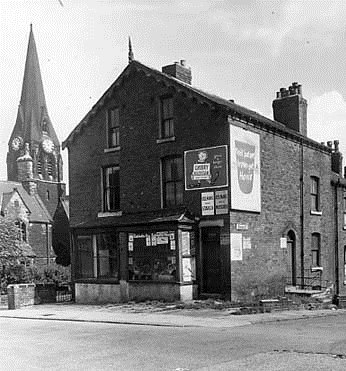
Address in 1866 on the Petition: 78 Camp Road, Little London
Marital Status: widow
Occupation: Lodging House Keeper
In the 1861 census, Mrs Carter had 2 lodgers and could afford a servant.
76 and 78 Camp Road in 1958. 78 is the empty shop on the right. Camp Road was improved in 1897 and again in the 1930s. It was re-named Oatland Lane and Lovell Park Road
Eliza Embleton 1814-1879
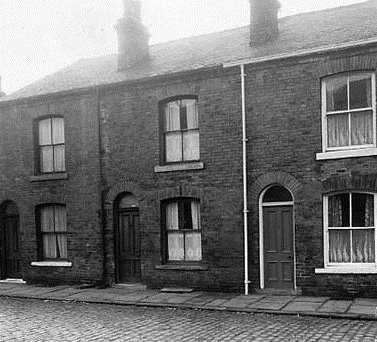
Address in 1866 on the Petition: 65 Burley Road
Marital Status: Widow
Occupation: Bookseller and Stationer
Eliza was born and married William Embleton in Sheffield but by 1851 they and their four children were living in Burley Terrace, Leeds and William was employed as a book-keeper at an iron works. Two more children were born before William died in 1855. Eliza moved to Burley Road and opened her own quite successful business. She could afford to have her sons educated; one is in the 1871 census as a mechanical draughtsman and another is a bookbinder. Her daughters became a milliner, a dressmaker and a domestic servant. When Eliza died, she left an estate worth £800, around £75,000 today.
Martha Fenton - 1822-1878
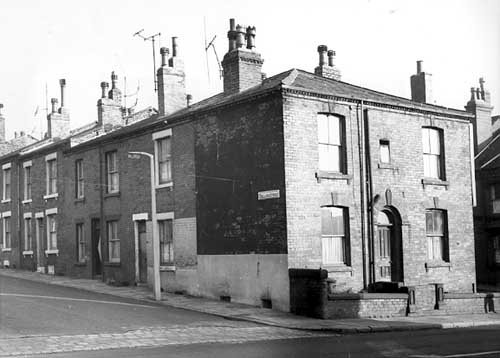
Courtesy of Leeds Library & Information Services
Address in 1866 on the Petition: 151 Woodhouse Street
Marital Status: Widow
Occupation: Laundress
Martha was the daughter of a shoemaker. She married a cooper. When she got married, only her husband could sign the Register, indicating that she and her father were illiterate. Martha was widowed in 1857 and her third daughter was born after her father’s death. In the 1861 census, she was described as “taking in washing” and her eldest daughter, aged 13, worked in a thread mill. In the 1871 census, Hannah was a laundress and her two eldest daughters were weavers.
Sarah Fisher - born 1813
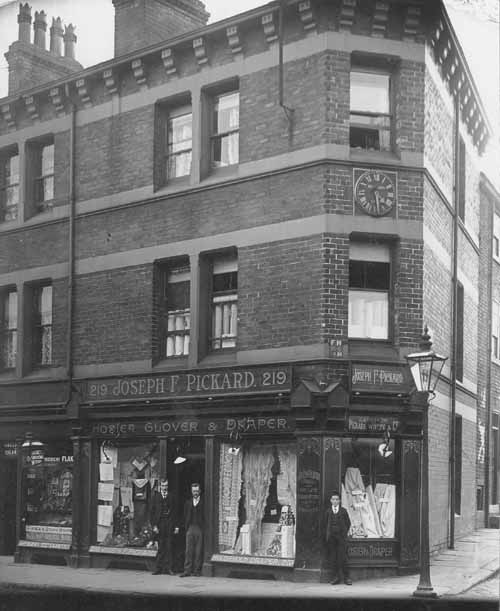
Address in 1866 on the Petition: 2 Cemetery Street, Woodhouse
Marital Status: widow
Occupation: Lodging House Keeper
In the 1861 census, Mrs Fisher had 3 lodgers but no live-in servant
This photograph, taken in 1904, shows the junction of Cemetery Street and Woodhouse Street, opposite the Packhorse public house. The buildings were demolished in 1960 to make way for the Department of Civil & Mechanical Engineering at the University of Leeds.
Part of Cemetery Street still exists, leading to General Cemetery at Woodhouse.
Kate Hall - 1827 - 1910
Address in 1866 on the Petition: St John’s Road
Marital status: Widow
Occupation: Boarding House Landlady
Widow of Edward Hall, Unitarian Minister at the Holbeck Domestic Mission, a project for the poor financed by Mill Hill Chapel.
In the 1861 census, Kate was already a widow with 3 sons, running a machine quilting shop in Skinner Lane.
In the 1871 census, she was living with two of her sons, aged 15 and 13 but both working as solicitors’ clerks, at this address in St John’s Road. There were also 4 lodgers and a servant: like many widows, Kate had to take in lodgers to make ends meet.
Barbara and Sarah Loftus (mother and daughter)
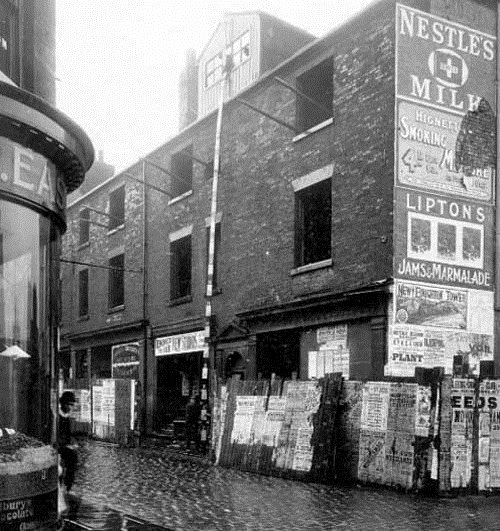
Born: Barbara 1799 but Sarah’s dates are unknown
Address in 1866 on the Petition: 88 Woodhouse Lane (demolished)
Marital Status: Barbara: widow
Sarah: single
Occupation: Shop Keeper
In the 1861 census, Mrs Loftus had 3 daughters living at home, all working as dressmakers, and a lodger.
The photograph shows Woodhouse Lane in 1906 prior to redevelopment. The area was demolished in the 1960s to make way for what is now Leeds Beckett University and the inner ring road.
Frances Lumley - 1818-1899
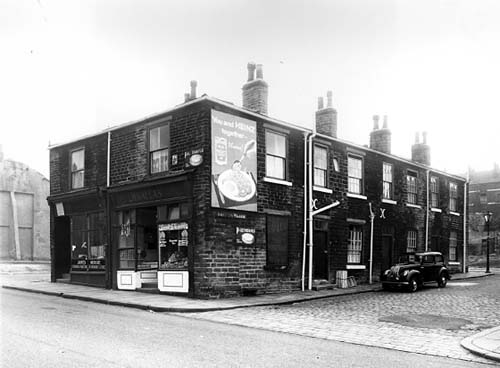
Address in 1866 on the Petition: 3 Raglan Place
Marital status: Widow
Occupation: Laundress
Widow of William Lumley, a coachman. 4 children.
In the 1891 census she was living in the Harrison Alms Houses in Raglan Road
The photograph shows 3-7 Raglan Place, off Raglan Road. These and the surrounding houses were demolished in the 1970s.
Ann Northwood - Born 1798
Address in 1866 on the Petition: 39 Fore Street, Woodhouse
Marital Status: widow
Occupation: Dairy Keeper
In the 1861 census, Mrs Northwood employed 3 live-in general servants
Martha Smithson
Address in 1866 on the Petition: 173 Woodhouse Street
Marital Status: widow
Occupation: Cloth Fettler
This area was demolished in the 1970s
Emma Tingle - Born 1832
Address in 1866 on the Petition: 159 Woodhouse Street
Marital Status: widow
Occupation: Charwoman
In the 1871 census, Mrs Carter moved to 141 Woodhouse Street. She had 3 daughters, the eldest also working as a charwoman and the others noted as “scholars”. Her son was a leather dresser.
At the same address in 1866 was
H. M. Pennington
In 1868 she is noted as a member of the Manchester Society for Women's Suffrage, as is Constance Holland - evidence that the Leeds Suffrage Society welcomed members across the classes.
This area of Woodhouse Street was demolished in the 1970s.
1 - Jane Airedall (or Ardill) - 9 Moor Street (probably now Moorfield Street)
2 - Charlotte Alderson - 18 West End Terrace (behind Hyde Park pub)
3 - Ann Briggs and Hannah Bolton - 51 and 55 Wade Lane (City Centre)
4 - Henrietta Carter - 78 Camp Road, Little London
5 - Eliza Embleton - 65 Burley Road
6 - Martha Fenton - 151 Woodhouse Street
7 - Sarah Fisher - 2 Cemetery Street
8 - Kate Hall - St John's Road (off Belle Vue Road)
9 - Barbara and Sarah Loftus - 88 Woodhouse Lane
10 - Frances Lumley - 3 Raglan Place
11 - Ann Northwood - 39 Fore Street ???
12 - Martha Smithson - 173 Woodhouse Street
13 - Emma Tingle and H.M. Pennington - 159 Woodhouse Street
Also :
14 - Ellen Heaton
15 - Constance Holland